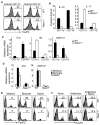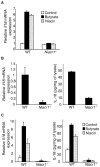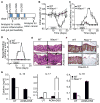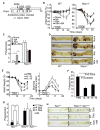Activation of Gpr109a, receptor for niacin and the commensal metabolite butyrate, suppresses colonic inflammation and carcinogenesis
- PMID: 24412617
- PMCID: PMC4305274
- DOI: 10.1016/j.immuni.2013.12.007
Activation of Gpr109a, receptor for niacin and the commensal metabolite butyrate, suppresses colonic inflammation and carcinogenesis
Abstract
Commensal gut microflora and dietary fiber protect against colonic inflammation and colon cancer through unknown targets. Butyrate, a bacterial product from fermentation of dietary fiber in the colon, has been implicated in this process. GPR109A (encoded by Niacr1) is a receptor for butyrate in the colon. GPR109A is also a receptor for niacin, which is also produced by gut microbiota and suppresses intestinal inflammation. Here we showed that Gpr109a signaling promoted anti-inflammatory properties in colonic macrophages and dendritic cells and enabled them to induce differentiation of Treg cells and IL-10-producing T cells. Moreover, Gpr109a was essential for butyrate-mediated induction of IL-18 in colonic epithelium. Consequently, Niacr1(-/-) mice were susceptible to development of colonic inflammation and colon cancer. Niacin, a pharmacological Gpr109a agonist, suppressed colitis and colon cancer in a Gpr109a-dependent manner. Thus, Gpr10a has an essential role in mediating the beneficial effects of gut microbiota and dietary fiber in colon.
Copyright © 2014 Elsevier Inc. All rights reserved.
Figures







Comment in
-
GPR109a: the missing link between microbiome and good health?Immunity. 2014 Jan 16;40(1):8-10. doi: 10.1016/j.immuni.2013.12.009. Immunity. 2014. PMID: 24439263 Free PMC article.
References
-
- Backhed F, Ley RE, Sonnenburg JL, Peterson DA, Gordon JI. Host-bacterial mutualism in the human intestine. Science. 2005;307:1915–1920. - PubMed
-
- Blad CC, Tang C, Offermanns S. G protein-coupled receptors for energy metabolites as new therapeutic targets. Nat Rev Drug Discov. 2012;11:603–619. - PubMed
Publication types
MeSH terms
Substances
Grants and funding
LinkOut - more resources
Full Text Sources
Other Literature Sources
Molecular Biology Databases
Miscellaneous

